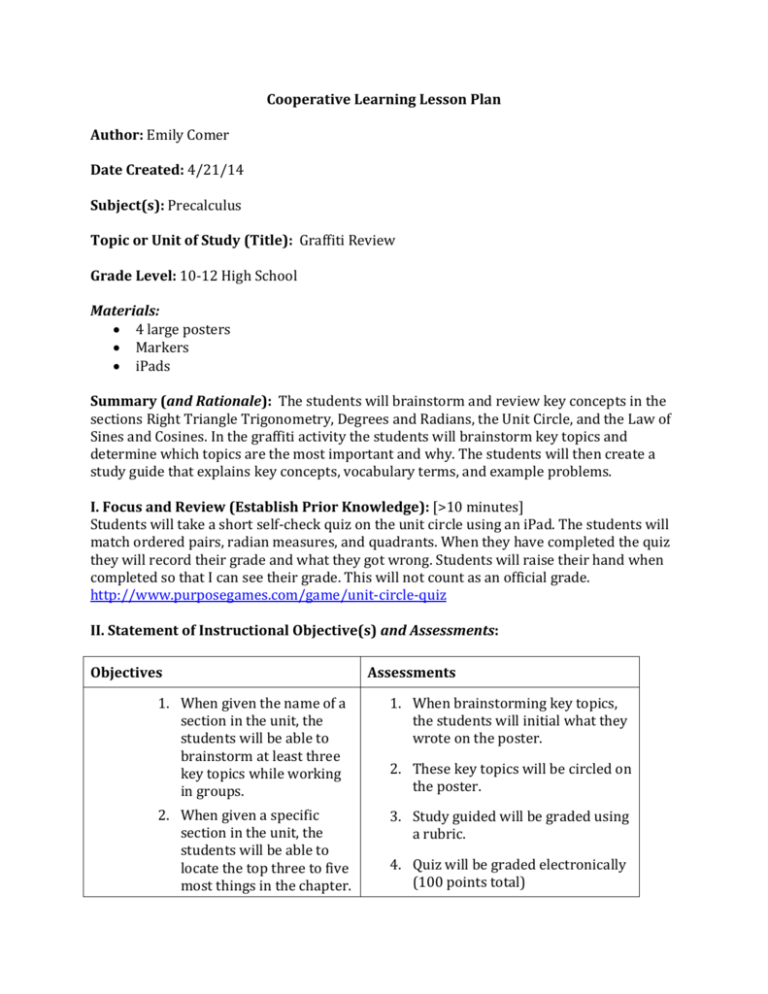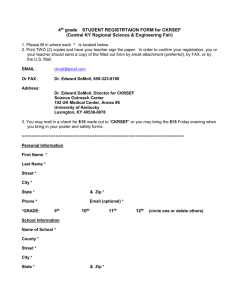Cooperative Learning Lesson Plan
advertisement

Cooperative Learning Lesson Plan Author: Emily Comer Date Created: 4/21/14 Subject(s): Precalculus Topic or Unit of Study (Title): Graffiti Review Grade Level: 10-12 High School Materials: 4 large posters Markers iPads Summary (and Rationale): The students will brainstorm and review key concepts in the sections Right Triangle Trigonometry, Degrees and Radians, the Unit Circle, and the Law of Sines and Cosines. In the graffiti activity the students will brainstorm key topics and determine which topics are the most important and why. The students will then create a study guide that explains key concepts, vocabulary terms, and example problems. I. Focus and Review (Establish Prior Knowledge): [>10 minutes] Students will take a short self-check quiz on the unit circle using an iPad. The students will match ordered pairs, radian measures, and quadrants. When they have completed the quiz they will record their grade and what they got wrong. Students will raise their hand when completed so that I can see their grade. This will not count as an official grade. http://www.purposegames.com/game/unit-circle-quiz II. Statement of Instructional Objective(s) and Assessments: Objectives Assessments 1. When given the name of a section in the unit, the students will be able to brainstorm at least three key topics while working in groups. 1. When brainstorming key topics, the students will initial what they wrote on the poster. 2. When given a specific section in the unit, the students will be able to locate the top three to five most things in the chapter. 3. Study guided will be graded using a rubric. 2. These key topics will be circled on the poster. 4. Quiz will be graded electronically (100 points total) 3. When given a specific section in the unit, the students will be able to create a study guide that includes at least 3 key concepts, ALL vocabulary words, and 4 example problems while working in groups. 4. When given a unit circle, the students will be able to label coordinates, radian measures, and quadrants with at least 75% correct. III. Teacher Input (Present tasks, information and guidance): [15 minutes] The teacher will introduce the graffiti model. Students will be put into five groups. Around the room are 4 posters labeled right triangle trigonometry, degrees and radians, the unit circle, and the Law of Sines and Cosines. 4 of the groups will go to the posters and the fifth will have a quick conference with me where I will give them a slip of paper telling if they are missing any work and their current grade in the class. Each group will have a different color marker and will spend about 3 minutes brainstorming and writing anything that they can think of that is related to the subject labeled on their poster. The students can write definitions, vocabulary terms, state examples, or draw pictures. Each student will write their initials by what they wrote on the poster. When the timer beeps, the groups will move on to the next station. If they brainstorm any ideas that are already written on the poster they will draw a check mark showing that they agree. They will also initial each check mark. After the groups have had an opportunity at each station, we will discuss the process of Graffiti and the purpose of the activity so that the students will have a better understanding of the activity for the next time we do it. IV. Guided Practice (Elicit performance): [15 minutes] The students will have the opportunity to reexamine the four posters and decide which topic most interests them. Based on their section of interest, students will get into new groups. They will look at what is on the poster and circle what they think are the three-five most important things from that section. They will discuss within the group why they are the most important. Guided Questions: 1. Why is this important for the section? 2. How do these things relate to the information from other sections? 3. What types of problems are we trying to solve? 4. How are these things related? V. Closure (Plan for maintenance): [2 minutes] As a class we will BRIEFLY discuss why it is important to break down different topics within a chapter and look for patterns or shared characteristics. We will also discuss why it is important to form a study guide when studying for a test or a quiz and how this study guide can be formed independently. VI. Independent Practice: [50 minutes] The students will break down into groups of three-five students. Students will work in interest grouping to create a study guide with practice problems on the section of the chapter that they chose. The study guide needs to include a clear outline of the section. It should include 4 practice examples that well represent the section. An answer key should be sent to THE TEACHER ONLY. Drawings, graphs, and/or charts must be included somewhere in the study guide. They should be clear and easy to read. An overall theme of the section should be evident. Each group will be given one iPad that they will use to scan a picture of their study guide and example problems onto the class website. Each student will have a role in the making of this study guide. The roles for a group of four include: 1. A student who is responsible for referencing the textbook, class notes, worksheets, and homework assignments. 2. A student who is records ideas for the study guide. 3. A student who writes out the final draft and includes clear and concise drawings and/or charts. 4. A student who takes pictures of the work and uploads and submits their study guide to the class website. If there are five students in a group, the job of writing the final draft can be split in half. If there are three students in the group, the student who references can submit the assignment. STANDARDS: CCSS.MATH.CONTENT.HSG.SRT.D.10 Prove the Laws of Sines and Cosines and use them to solve problems. CCSS.MATH.CONTENT.HSG.SRT.D.11 Understand and apply the Law of Sines and the Law of Cosines to find unknown measurements in right and non-right triangles. CCSS.MATH.CONTENT.HSF.TF.A.1 Understand radian measure of an angle as the length of the arc on the unit circle subtended by the angle. CCSS.MATH.CONTENT.HSF.TF.A.2 Explain how the unit circle in the coordinate plane enables the extension of trigonometric functions to all real numbers, interpreted as radian measures of angles traversed counterclockwise around the unit circle. CCSS.MATH.CONTENT.HSG.SRT.C.8 Use trigonometric ratios and the Pythagorean Theorem to solve right triangles in applied problems. HS.TT.1 Use technology and other resources for assigned tasks. HS.TT.1.3 Use appropriate technology tools and other resources to design products to share information with others (e.g. multimedia presentations, Web 2.0 tools, graphics, podcasts, and audio files). Plans for Individual Differences: In Guided Practice, the students will be able to choose which section of the unit interests them the most. They will be able to use their knowledge and understanding to create a successful study guide that will help others understand the material. For the students who are struggling to narrow down to three to five main topics, I will use guided questions to lead them in the right direction. In the independent practice, the students will be able to choose which job in the project best reflects their strengths. References (APA style): Purpose Games. (2013). Unit Circle. Retrieved from: http://www.purposegames.com/game/unit-circle-quiz




